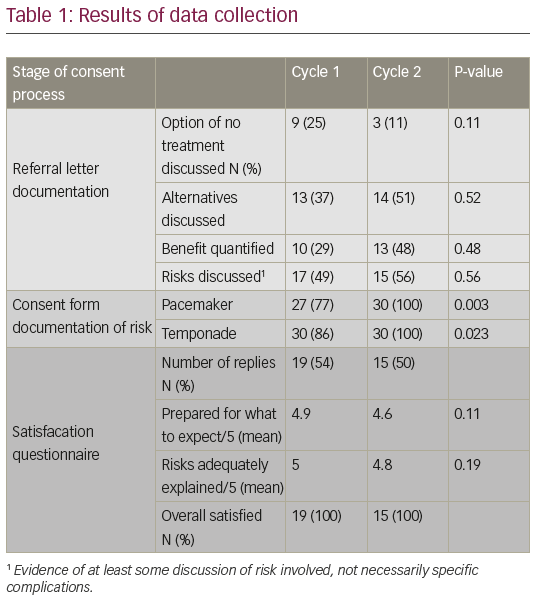Introduction: Informed consent is fundamental to good medical practice and reflects the ethical principles at the heart of realistic medicine. However, the practice of obtaining informed consent varies widely, with potentially severe medical and legal consequences. Bearing in mind that consent is a process and not a one-time event, we sought to assess the effectiveness of current practice in obtaining informed consent both in relation to effective documentation and patient satisfaction, and assess whether the introduction of a new procedure-specific consent form and information leaflet could improve this.
Methods: Prospective data collection from case notes and patient satisfaction survey for elective diagnostic electrophysiology procedures over two 1-month periods before and after the introduction of procedural specific consent forms and information leaflets. We assessed:
a) was there any documentation of a discussion regarding risks and benefits and alternatives to the procedure in clinic, prior to referral?
b) were relevant, material risks documented in the consent form for the procedure? (specifically risk of requiring a pacemaker and risk of cardiac tamponade); and
c) were patients satisfied with the consent process?
We excluded inpatient (urgent) ablation procedures. Data were expressed as simple frequencies and averages, with a paired T-test used to assess for any significant difference in means.
Results: There were 35 patients in cycle 1 and 30 patients in cycle 2. In both cycles, documentation of a discussion about risks, benefits and alternatives to the procedure in the referral clinic letter was poor. There
was a considerable improvement in the documentation of all risks in the consent form in cycle 2. However, patient satisfaction with key aspects of the consent process was high in both cycles (Table 1). No complications were recorded for any of the procedures performed.
Conclusions: Although absolute numbers are small, the use of pre-printed consent forms can significantly improve documentation of material procedure-associated risks. However, patient satisfaction with the process was high regardless of whether or not a procedure-specific consent form was used. Further, larger studies would be required to assess whether this remained the case for more varied patient groups, and whether or not the occurrence of a complication affected how well patients believed they had been informed about the procedure
beforehand.








